Abstract
The uncertainty of wind power and photoelectric power output will cause fluctuations in system frequency and power quality. To ensure the stable operation of the power system, a comprehensive scheduling optimization model for the electricity-to-gas integrated energy system is proposed. Power-to-gas (P2G) technology enhances the flexibility of the integrated energy system and the power system in absorbing renewable energy. In this context, firstly, an electricity-to-gas optimization scheduling model is proposed, and the improved Conditional Value at Risk (CVaR) is proposed to deal with the uncertainty of wind power and photoelectric power output. Secondly, taking the integrated energy system with the P2G operating cost and the carbon emission cost as the objective function, an optimal scheduling model of the multi-energy system is solved by the A Mathematical Programming Language (AMPL) solver. Finally, the results of the example illustrate the optimal multi-energy system scheduling model and analyze the economic benefits of the P2G technology to improve the system to absorb wind power and photovoltaic power. The simulation calculation of the proposed model demonstrates the necessity of taking into account the operating cost of the electrical gas conversion in the integrated energy system, and the feasibility of considering the economic and wind power acceptance capabilities.
1. Introduction
Complementary operation between multiple energy sources is conducive to improving the efficiency of renewable energy utilization. In 2015, China clearly put forward the strategy of “strengthening energy interconnection and promoting multi-energy optimization and complementarity” in the guidance of promoting the development of a smart grid [1]. The development of renewable energy is a national strategic demand to ensure the establishment of China’s energy sustainable development system and complete the energy technology revolution [2]. The volatility of large-scale renewable energy has increased the pressure on grid dispatching [3]. Therefore, the characteristics of wind energy and solar energy resources are studied, and then a reasonable optimization model power system is proposed for dispatching and is rationally allocated [4]. The optimal dispatching operation of an integrated energy system as an important physical carrier is the key to achieving abandonment [5].
As energy storage technology has developed, it has become a key technology to improve the flexibility, security, and stability of the energy Internet and improve the consumption of renewable energy [6]. The application of energy storage to stabilize wind power fluctuations has been studied by many scholars. Jabr et al. [7] studied an integrated optimization model of system operation for an energy storage system, and a wind thermal water storage gas joint optimization scheduling model was constructed. We further study the coordinated scheduling model of thermal power storage with energy storage and propose a combined solution method based on bilevel programming and opportunity constrained goal planning [8]. Energy storage is used to smooth the wind power output curve, effectively reducing the difficulty of grid regulation. The coupling of traditional power systems and natural gas systems is the conversion of natural gas to electrical energy [9]. Power-to-gas (P2G) technology may change this situation, and a model for peak-filling and valley filling through P2G and gas turbine coordination is proposed, taking into account the economic goals of the system and the peak-filling target. Gahleitner [3] provided a new idea for large-scale storage of electric energy, electrochemically reacting surplus electric energy to turn water and carbon dioxide into artificial natural gas that is injected into the natural gas network. The key technologies of each link of P2G are introduced in detail, and the cost is systematically analyzed [10]. In addition, P2G technology can convert electrical energy into natural gas when the transmission line is blocked, and can send it through the natural gas pipeline to the gas unit that is not in the blocking area to generate electricity to alleviate system blockage. P2G technology can promote the integration of electrical networks and natural gas systems, and is an important part of integrated energy systems [11]. The cost characteristics and operational economy of P2G applications in different scenarios are studied.
The breakthrough of electro-gas technology and the application of cogeneration technology will bring the power network and natural gas network closer together, providing a new way to eliminate renewable energy [12,13]. The gradual maturity and application of P2G technology increase the flexibility of the energy system to operate. Chaudry et al. [14] described the application and development potential of P2G technology in Germany, and the German Energy Agency and China have also begun to cooperate. The energy management system [15] integrates power generation optimization scheduling, load management, real-time monitoring and automatic realization of micro-grid synchronization and other functions. With the continuous development of the system and the expansion of its scale, it will face a series of problems that need to be solved, such as control structure, optimization algorithms, and communication design.
The convergence of power networks and natural gas networks will present new challenges to the operation of energy systems. Although there have been some studies on the coordinated scheduling of natural gas and power systems, such as CHP or CCHP, the modeling method lacks versatility [16]. Jabr et al. [17] assessed the feasibility of P2G’s participation in the energy market by purchasing electricity and selling natural gas. The energy center modeling method is proposed to integrate energy systems such as electric power, natural gas, and heating networks for modeling. Because of its versatility and scalability, this method is widely used to solve various problems related to multi-energy systems [18]. P2G technology is still in the initial stage of development, and the relevant research literature is relatively scarce [19]. Wei et al. [20] used two-stage optimal power flow method to evaluate the impact of P2G technology on power networks and natural gas networks. The gas-electric network considering wind power uncertainty is proposed, the commercial application of P2G technology enables energy to flow in both directions between the power system and the natural gas system, thereby increase the flexibility of system operation [21,22]. The development potential of P2G technology in Germany is expounded, and the impact of P2G technology on the power system and natural gas system is analyzed. In general, the existing literature is in the exploration stage for the collaborative planning of power systems and natural gas systems with P2G.
At present, in the existing research on the optimization of integrated energy systems with P2G, it is rare to consider the impact of P2G operating costs on the scheduling operation of integrated energy systems. In fact, when the P2G operating cost is high, it will affect the wind power acceptance capability and operational economy of the system to a certain extent, so that there is a certain contradiction between the two. Furthermore, it is important to coordinate the relationship between the renewable energy system and gas system, and ensure the economical operation of the system with high wind power acceptance capability, which is a key issue facing the integrated energy system with P2G.
In the above context, this paper will focus on the market equilibrium of multi-energy systems with P2G equipment. This paper establishes a risk optimization model under the Conditional Value at Risk (CVaR) framework for the decision-making problem of electricity-to-gas in the power market environment, that is, under the premise of a given probability of confidence level, the comprehensive energy system benefits the largest. First, an integrated energy system with P2G equipment is based on an energy center modeling approach. Secondly, taking the minimum difference between system power generation cost and carbon emission cost as the optimization goal, to determine the optimal input capacity of each unit at each time period and optimize the energy utilization of the system.
2. System Scheduling Risk Assessment Model
2.1. Structure of Integrated Energy System with P2G
The energy supply system mainly includes wind turbines, photovoltaic power plants, gas generating units, energy storage power stations, and gas storage systems. The system can realize gas-electricity conversion, participate in bidding in the electricity market and the natural gas market, and maximize the flat load demand curve. The gas storage system can store the CH4 generated by gas conversion in the valley period and release the natural gas to obtain economic benefits in the peak period. Figure 1 is the structure of the integrated energy system with P2G:
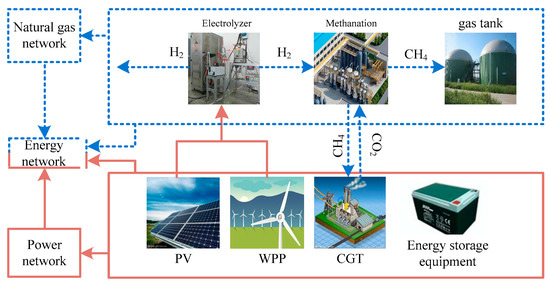
Figure 1.
The structure of the integrated energy system with power-to-gas (P2G).
The energy supply system consists of two parts: the power system and the natural gas system. The gas storage system consists of two parts: the P2G and the gas storage equipment. P2G is driven by wind power and photovoltaic and uses the CO2 generated by the gas unit. Wind turbines and photovoltaic power plants are the main power sources for the system. the gas unit provides a reserve service for the system. If the energy supply capacity is insufficient, the gas storage system can supply CH4 to the gas unit.
2.1.1. Unit Output Power Model
The randomness and uncertainty of wind power and photovoltaic output depend on the randomness of wind speed and light radiation in the region, and wind speed and light radiation are susceptible to weather factors and terrain conditions. Although wind power and photovoltaic output have randomness and uncertainty, considerable statistical data indicate that wind speed is subject to Weibull distribution, for the specific formula of wind power output, refer to the literature [23]. The output curve of the photovoltaic power system generally satisfies the Beta distribution, for the specific formula of wind power output, refer to the literature.
2.1.2. Time-Of-Use Pricing Design
Assuming that the Time of Use (TOU) price parameters remain unchanged for a certain period of time, the relationship between transferred load and price elasticity coefficient is as follows:
where in is user load at time t; is the user load after transferring at time t; and is the price elastic coefficient transferred load from time k to time t, . and are the electricity price of the time-of-use (TOU). The basic period is 1 h.
2.1.3. Gas Storage Facility Storage Model
Gas storage tanks can store a large amount of electric energy, enable interconnection of the electric–gas network and an increase connectivity in new energy grids, and reduce the system carbon emissions. Gas storage tanks include electrical gas and gas storage equipment, which converts electrical energy to either hydrogen or natural gas. Figure 2 is a schematic diagram of the P2G technology.

Figure 2.
Schematic diagram of the P2G technology.
P2G is divided into two processes: electrolysis and methanation. Electrolysis is generating excess hydrogen through electrolyzed water. The chemical reaction of electrolyzed water is as follows:
Through the above two stages of chemical reactions, the efficiency of P2G is approximately 45% to 60%. After the electric energy is converted into natural gas, it can be injected into the gas storage tank. The P2G chemical reaction consumes CO2 and reduces the carbon emissions generated by the system. P2G uses the CO2 generated by the gas unit to inject CH4 into the gas unit during peak hours. The specific formula is as follows:
where in is the amount of natural gas produced by P2G is at time t, is the power consumed by P2G at time t, is the conversion efficiency of P2G, and is the calorific value of natural gas. The energy status in the gas tank can be expressed as follows:
where in is the capacity of the gas tank at time t, is the capacity of the gas tank in the initial stage, is the natural gas capacity injected into the gas storage tank at time t, is the natural gas capacity of the gas tank injected into the gas unit at time t, and is the capacity of the gas tank to inject into the network at time t.
2.2. Uncertainty Set
and are the minimum and maximum output ranges, respectively, of wind power at time t. and are the minimum and maximum output ranges, respectively, of photovoltaic power at time t. The concrete formula is as follows:
The absolute predictive error of wind and photovoltaic power is constrained by the 1-norm, and the parameter is the uncertainty coefficient.
where in and are the uncertainty coefficients of wind and photovoltaic power output. The above problem is a linear constrained two-objective optimization.
2.3. Improved CVaR Risk Assessment Model
In this paper, CVaR is derived from Value at Risk (VaR), which is the “conditional risk value” of system uncertainties. Supposing is a random variable, represents VaR at a confidence level. is the loss exceeds the expected value. The specific formula is as follows:
where in is the quntile of random variable ; As VaR is not subadditive, the CVaR is used to measure the risk value of uncertainties. In this paper, we use the Cornish-Fisher expansion to approximate the X percentile of uncertain factors. The approximate value of is expressed as Equation (11):
where in is the mean of uncertainty X, is the standard deviation of uncertainty X, is a standard normal distribution percentile, is the skewness of uncertainty X, and is the kurtosis of uncertainty. The uncertainty X of percentile is . , and the of uncertainty X is expressed as Equation (12):
where in , , and is the probability density function of the normal distribution of uncertain factors. The normal distribution uncertainty factors X’s and calculations are as follows Equations (13) and (14):
3. Optimized Scheduling Model of P2G System
3.1. System Objective Function
3.1.1. System Operation Cost Minimization
Due to the volatility and randomness of photovoltaic panels and wind turbines in the system, the optimization objective is mainly to reduce the consumption of fossil energy and to achieve social benefits. Therefore, the cost of power generation is the objective of the system
where in is the 0–1 integer state function of unit i at time t, is the start and stop cost of unit i, is the gas consumption function of the unit i, and , , and is the gas unit consumption coefficient.
where in is the cost for the system operating, and is the cost of purchasing electricity for the system.
3.1.2. System Carbon Emissions’ Minimization
Minimization of the carbon emissions of the system is taken as an objective function, and the specific relationship is as follows:
where in is the total carbon emissions cost of the system, and , , and is the carbon emission coefficient of generator i. is the price of CO2. is the total cost of the system.
3.2. System Constraints
(1). Electricity power balance
(2) Heating balance
(3). Cooling balance
(4). Generator set constraints
Gas unit constraints include mainly upper and lower power constraints, climbing constraints, minimum start time constraints, and minimum downtime constraints. The energy storage equipment stores electricity in valley periods and discharges in peak periods, which can effectively reduce the peak-to-valley difference of the load curve. Energy storage equipment output and constraint functions are described in the literature.
4. Example Analysis
4.1. Simulation Scenario Setting
The gas storage system can store the natural gas generated by P2G in the low valley period according to the supply and demand situation of the load. During peak periods, the CH4 is released for the gas unit, which increases the flexibility of the energy supply system. Similarly, the demand response uses the TOU electricity price to smooth the load demand curve. Therefore, this paper sets up simulation scenarios of a multi-objective model according to gas storage system and the TOU electricity price. The specific scenarios are as follows:
Scenario 1: the system has no P2G and demand response. As a basic scenario, this scenario is used to discuss the conversion effect of energy sources in the system and to achieve stable output of the energy supply.
Scenario 2: the system has P2G and no demand response. This scenario is a comparative scenario that analyzes the impact of P2G equipment on the system.
Scenario 3: the system has P2G and demand response. This scenario is a comprehensive scenario that analyzes the synergistic optimization effects between TOU electricity prices and gas storage systems.
Scenario 4: this scenario has a confidence coefficient that is different from that of the above scenario. There is a direct relationship between the TOU electricity price and P2G, so this scenario focuses on the impact of different confidence factors on system operating costs.
Through the above four scenarios, we analyze the conversion effect within the energy supply system and the impact of the gas storage system and the TOU electricity price on the operation of the system. There are nonlinear constraints in constraints of gas units, and the proposed objective function and constraints should be linearized. The above problem is a mixed integer nonlinear programming problem, and the optimal solution is difficult to achieve.
4.2. Basic Data
The system is equipped with a battery energy storage system and a natural gas storage system. The equipment parameters of the integrated energy system are shown in Table 1:

Table 1.
The equipment parameters of the integrated energy system.
The TOU price is shown in Table 2.

Table 2.
Time of Use (TOU) price of 24 h.
For convenient calculation, the average value of each parameter is selected. The specific coefficients are shown in Table 3:

Table 3.
Unit emission coefficient.
4.3. Simulation Result Analysis
4.3.1. Analysis of System Operation Cost under Different Scenarios
AMPL (A Mathematical Programming Language) is a powerful and flexible comprehensive mathematical model language that solves the linear, nonlinear and integer mathematical programming problems often encountered in the optimization process. AMPL is a modeling language that describes and solves large-scale complex mathematical problems. AMPL supports most of the world’s solvers, such as CBC (2009), CPLEX (2009) software. A major feature of the AMPL language is the simplification of mathematical expressions for optimization problems, which makes it possible to define optimization problems in a concise manner. The simulation results show that the optimized scheduling scheme can achieve the consumption of renewable energy, and the TOU electricity price improves the economics of the operation of the integrated energy system. Figure 3 shows Scenario 1 for the output structure of each device in the system.
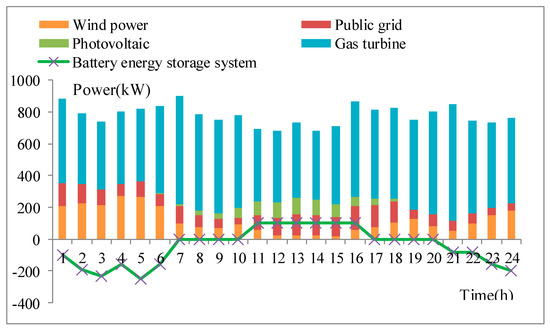
Figure 3.
The output structure of each device in Scenario 1.
It can be seen from Figure 3 that the wind power and photovoltaic system can meet the system’s electrical load and heat and cooling load, and the energy storage equipment can achieve efficient energy utilization. Systems that consider the uncertainty of wind power output will increase operating costs, but can effectively avoid the greater losses caused by wind abandonment. Therefore, economic losses are effectively avoided by introducing system energy storage and the TOU electricity price. Figure 4 shows the output structure of each device in Scenario 2.
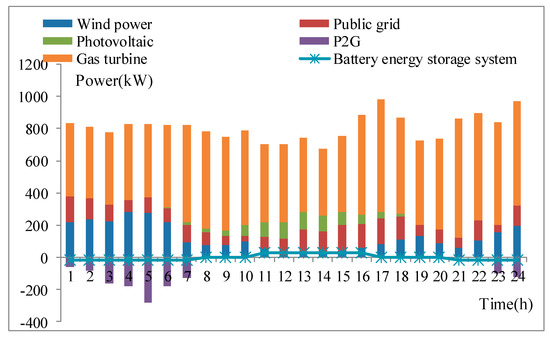
Figure 4.
The output structure of each device in Scenario 2.
P2G equipment converts excess wind and photovoltaic power into natural gas, which is stored by the system, reducing the amount of natural gas obtained from the station. The power purchased by the public grid does not increase during the peak load, which reduces the natural gas and power from the network, thereby reducing transmission losses. Figure 5 shows the output structure of each device in Scenario 3.
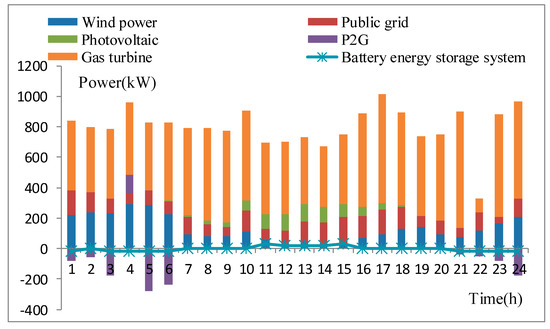
Figure 5.
The output structure of each device in Scenario 3.
P2G and the TOU electricity prices are configured in the system, which increases the output of wind power and photovoltaic system equipment and the energy flow between the various energy systems, and improves the energy utilization efficiency of wind and photovoltaic power. Figure 6 shows the output structure of each device in Scenario 4.
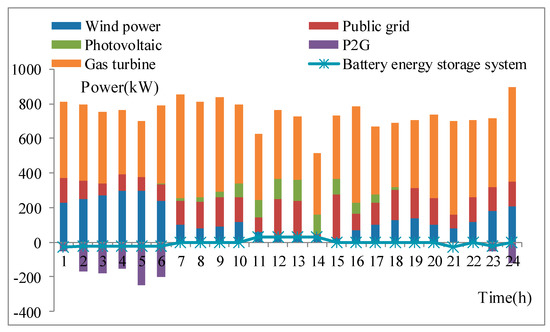
Figure 6.
The output structure of each device in Scenario 4.
In this paper, four scenarios are set up in the example section for comparison. The gas storage equipment can be adjusted optimally according to the system load requirements, which increases the wind power and photovoltaic grid connected capacity. The energy flow is enhanced in the various devices of the system, and the energy utilization efficiency of the system is improved. Table 4 shows the operating costs of the system in different scenarios.

Table 4.
The cost of the system in different scenarios.
P2G equipment reduces fossil energy consumption and system carbon emissions. Figure 7 shows the system wind power and photovoltaic grid-connected capacity under different scenarios.
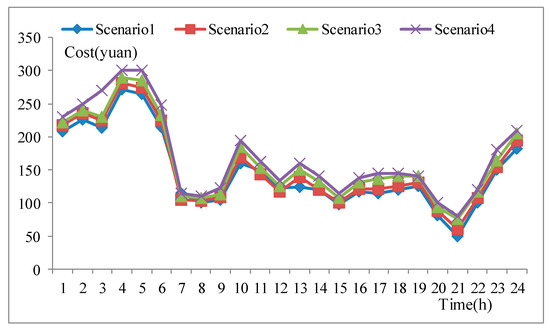
Figure 7.
The system wind power and photovoltaic grid-connected capacity under different scenarios.
Through the system simulation, the system makes full use of the TOU electricity price and improves the economic model of the integrated energy system. The TOU electricity price is introduced to transfer the load, thereby realizing the consistency of wind power output and load and reducing the problem of wind abandonment.
4.3.2. Analysis of the Relationship between Carbon Trading Price and System Cost
Carbon trading prices are low, system carbon emissions are slow, and system operations are dominated by economic targets. However, as carbon trading prices increase, carbon trading costs and system power generation costs are increasing. As carbon trading prices increase, the system output begins to shift gas turbines, so the carbon trading cost and the system operating cost fall. As seen in Figure 8, the operating cost of an integrated energy system is sensitive to the fluctuation of carbon trading prices. Figure 8 presents is the relationship between carbon trading price and system cost.
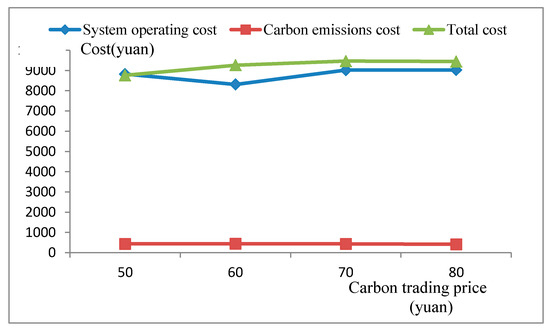
Figure 8.
The relationship between carbon trading price and system cost.
The carbon trading price has risen, and the reduction in system outsourcing power has reduced carbon emissions. If the price of carbon trading continues to increase so that the amount of purchased natural gas cannot continue to grow, the actual carbon emissions are no longer reduced, and the capacity changes affect the results of low-carbon economic dispatch. Within a certain range, as the P2G capacity increases it will reduce energy costs and have no impact on the cost of carbon emissions.
4.3.3. System Cost at Different Confidence Levels
Different confidence levels reflect the degree of risk aversion of the decision-makers, so it is necessary to study the impact of the confidence level on the scheduling results. Figure 9 shows the scheduling costs of CVaR, taking different confidence levels into account.
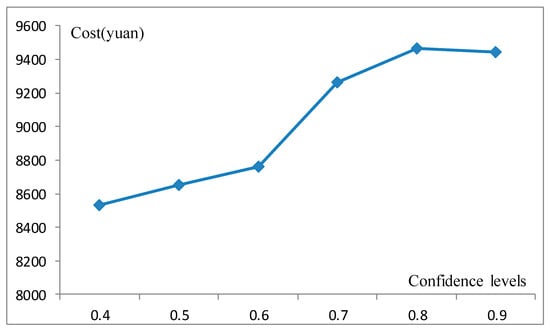
Figure 9.
Relationship between confidence level and system cost.
It can be seen that, as the confidence level increases, the total scheduling cost also increases. This reflects the improvement of the level of risk aversion by decision-makers. In addition, the confidence level can also be used as a safety indicator for system operation. The increase in confidence level indicates that the system has increased safety requirements, that the total operating cost of the system increases and the economics of the system deteriorate. Therefore, the dispatcher can determine the scheduling scheme of the system according to the actual situation and consider comprehensively the system operation requirements in regard to safety and economy.
5. Conclusions
This paper establishes an integrated energy system economic dispatch model that takes into account the conditional risk value. The model can introduce improved CVaR into the objective function of economic dispatching; the operator determines the level of confidence based on the level of risk aversion. The main contributions of this paper to the above issues are as follows:
P2G improves the wind power and photovoltaic grid connected capacity of the integrated energy system and can effectively slow down the fluctuation of the net load, but it also increases the economic cost of the system. The mechanism by which P2G impacts on the safety and reliability of integrated energy systems needs further study. The simulation results show that the confidence level is increased, the scheduling risk of the system increases, and the distribution of electric and thermal loads between the energy-providing devices also changes. Since the model takes into account the electricity, heat, and gas and the multi-energy flow constraint, the generated scheduling scheme can ensure the safe operation of the system. Thus, the unit power adjustment cost of the controllable energy-providing equipment will affect the distribution of the system operating cost, and the CVaR-based economic scheduling model proposed in this paper can be reduced.
In the day-to-day scheduling of integrated energy systems with P2G, this paper considers the impact of P2G operating costs on system wind power acceptance and operational economy, and proposes a multi-objective optimization model to coordinate the contradiction between the two. The results of the example show that the higher P2G operating cost will affect the wind power acceptance ability and operational economy of the system to a certain extent, which will cause certain contradictions between the two.
Author Contributions
Z.T. guided the research; Q.T. established the model, implemented the simulation and wrote this article; S.Y. collected references; L.J. and G.D. revised the language of this article.
Funding
Project Supported by National Natural Science Foundation of China (71573084) and Beijing Municipal Social Science Foundation (16JDYJB044). The authors declare no conflict of interest.
Conflicts of Interest
It should be noted that the whole work was accomplished by the authors collaboratively. All authors read and approved the final manuscript.
Nomenclature
| P2G | Power-to-gas |
| AMPL | A Mathematical Programming Language |
| CVaR | Conditional Value at Risk |
| VaR | value at risk |
| Q(t) | User load at time t |
| The user load after transferring at time t | |
| The price elastic coefficient transferred load from time k to time t | |
| , | are the electricity price of the time-of-use (TOU) |
| The amount of natural gas produced by P2G is at time t | |
| The power consumed by P2G at time t | |
| The conversion efficiency of P2G | |
| The calorific value of natural gas | |
| The capacity of the gas tank at time t | |
| The capacity of the gas tank in the initial stage | |
| The natural gas capacity injected into the gas storage tank at time t | |
| The natural gas capacity of the gas tank injected into the gas unit at time t | |
| The capacity of the gas tank to inject into the network at time t | |
| The minimum output of wind power at time t | |
| The maximum outputof wind power at time t | |
| The minimum output of photovoltaic power at time t | |
| The maximum outputof photovoltaic power at time t | |
| Γ | The uncertainty coefficient |
| The uncertainty coefficients of wind power output | |
| The uncertainty coefficients of photovoltaic power output | |
| Random variable | |
| The approximate value | |
| The mean of uncertainty X | |
| The standard deviation of uncertainty X | |
| Astandard normal distribution α percentile | |
| The skewness of uncertainty X | |
| The kurtosis of uncertainty | |
| The probability density function of the normal distribution of uncertain factors | |
| The 0-1 integer state function of unit i at time t | |
| The start and stop cost of unit i | |
| The gas consumption function of the unit i | |
| , , | The gas unit consumption coefficient |
| The cost for the system operating | |
| The cost of purchasing electricity for the system | |
| The total carbon emissions cost of the system | |
| ,, | The carbon emission coefficient of generator i |
| The price of CO2 | |
| The total cost of the system | |
| The power generation output of gas turbine at time t | |
| The wind power output at time t | |
| The photovoltaic power output at time t | |
| The power consumption ratio of the system | |
| The power for RE at time t | |
| The power for EC at time | |
| The electrical load of other equipment at time t | |
| The power buying from the grid at time t | |
| The power required for P2G | |
| the power required for ST | |
| The heating load provided by GB at time t | |
| The heating load provided by HE at time t | |
| The heating energy load required by the system at time t. | |
| The cooling energy generating by AC at time t | |
| The cooling energy generating by EC at time t | |
| The cooling energy load required by the buildings at time t |
References
- Dong, Z.; Zhao, J.; Wen, F.; Xue, Y. From smart grid to energy Internet: Basic concept and research frame work. Autom. Electr. Power Syst. 2014, 38, 1–11. [Google Scholar]
- Xue, Y. Energy Internet or comprehensive energy network. J. Mod. Power Syst. Clean Energy 2015, 3, 297–301. [Google Scholar] [CrossRef]
- Gahlitner, G. Hydrogen from renewable electricity: An international review of power-to gas pilot plants for stationary application. Int. J. Hydrogen Energy 2013, 38, 2039–2061. [Google Scholar] [CrossRef]
- Ma, Z.; Zhou, X.; Shang, Y.; Sheng, W.X. Exploring the concept, key technologies and development model of energy Internet. Power Syst. Technol. 2015, 39, 3014–3022. [Google Scholar]
- Salimi, M.; Ghasemi, H.; Adelpour, M.; Vaez-ZAdeh, S. Optimal planning of energy hubs in interconnected energy systems: A case study for natural gas and electricity. IET Gener. Transm. Distrib. 2015, 9, 695–707. [Google Scholar] [CrossRef]
- Clegg, S.; Mancarella, P. Integrated modeling and assessment of the operational impact of power-to-gas (P2G) on electrical and gas transmission networks. IEEE Trans. Sustain. Energy 2015, 6, 1234–1244. [Google Scholar] [CrossRef]
- Jabr, R.A.; Karaki, S.; Korbane, J.A. Robust Multi-Period OPF with Storage and Renewables. IEEE Trans. Power Syst. 2015, 30, 2790–2799. [Google Scholar] [CrossRef]
- Cheng, J.; Choobineh, F. A Novel Wind Energy Conversion System with Storage for Spillage Recovery. J. Power Energy Eng. 2015, 3, 33–38. [Google Scholar] [CrossRef]
- Nick, M.; Cherkaoui, R.; Paolone, M. Optimal Planning of Distributed Energy Storage Systems in Active Distribution Networks Embedding Grid Reconfiguration. IEEE Trans. Power Syst. 2018, 33, 1577–1590. [Google Scholar] [CrossRef]
- Díaz-González, F.; Sumper, A.; Gomis-Bellmunt, O.; Villafáfila-Robles, R. A review of energy storage technologies for wind power applications. Renew. Sustain. Energy Rev. 2012, 16, 2154–2171. [Google Scholar] [CrossRef]
- Zhao, H.; Wu, Q.; Hu, S.; Xu, H.; Rasmussen, C.N. Review of energy storage system for wind power integration support. Appl. Energy 2015, 137, 545–553. [Google Scholar] [CrossRef]
- Clegg, S.; Mancarella, P. Storing renewables in the gas network: Modelling of power-to-gas seasonal storage flexibility in low-carbon power systems. IET Gener. Transm. Distrib. 2016, 10, 566–575. [Google Scholar] [CrossRef]
- Martinet-Mares, A.; Fuerte-Esquivel, C.R. A unified gas and power flow analysis in natural gas and electricity coupled networks. IEEE Trans. Power Syst. 2012, 27, 2156–2166. [Google Scholar] [CrossRef]
- Saldarriaga, C.; Hincapie, R.A.; Salazar, H. A holistic approach for planning natural gas and electricity distribution networks. IEEE Trans. Power Syst. 2013, 28, 4052–4063. [Google Scholar] [CrossRef]
- Chaudry, M.; Jenkins, N.; Qadrdan, M.; Wu, J. Combined gas and electricity network expansion planning. Appl. Energy 2014, 113, 1171–1187. [Google Scholar] [CrossRef]
- Gil, M.; Duenas, P.; Renews, J. Electricity and natural gas interdependency: Comparison of two methodologies for coupling large market models within the European regulatory framework. IEEE Trans. Power Syst. 2016, 31, 361–369. [Google Scholar] [CrossRef]
- Qiu, J.; Dong, Z.Y.; Zhao, J.H.; Xu, Y.; Zheng, Y.; Li, C.; Wong, K.P. Multi-Stage Flexible Expansion Co-Planning Under Uncertainties in a Combined Electricity and Gas Market. IEEE Trans. Power Syst. 2016, 30, 2119–2129. [Google Scholar] [CrossRef]
- Jabr, R.A.; Džafić, I.; Pal, B.C. Robust Optimization of Storage Investment on Transmission Networks. IEEE Trans. Power Syst. 2015, 30, 531–539. [Google Scholar] [CrossRef]
- Schiebahn, S.; Grube, T.; Robinius, M.; Tietze, V.; Kumar, B.; Stolten, D. Power to gas: Technological overview, systems analysis and economic assessment for a case study in Germany. Int. J. Hydrogen Energy 2015, 40, 4285–4294. [Google Scholar] [CrossRef]
- Sun, Y.Z.; Wu, J.; Li, G.J.; He, J. Dynamic economic dispatch considering wind power penetration based on wind speed forecasting and stochastic programming. Proc. CSEE 2009, 29, 41–47. [Google Scholar]
- Wei, L.K.; Zhao, B.; Wu, H.B.; Zhang, X.S. Optimal allocation model of BESS system in virtual power plant environment with a high penetration of distributed photovoltaic generation. Autom. Electr. Power Syst. 2015, 39, 66–74. [Google Scholar]
- Zheng, Y.; Dong, Z.Y.; Luo, F.J.; Meng, K.; Qiu, J.; Wong, K.P. Optimal Allocation of Energy Storage System for Risk Mitigation of DISCOs with High Renewable Penetrations. IEEE Trans. Power Syst. 2014, 29, 212–220. [Google Scholar] [CrossRef]
- Zhang, X.; Karady, G.Q.; Ariaratnam, S.T. Optimal allocation of CHP-baced distributed generation on urban energy distribution networks. IEEE Trans. Sustain. Energy 2014, 5, 246–253. [Google Scholar] [CrossRef]
© 2018 by the authors. Licensee MDPI, Basel, Switzerland. This article is an open access article distributed under the terms and conditions of the Creative Commons Attribution (CC BY) license (http://creativecommons.org/licenses/by/4.0/).